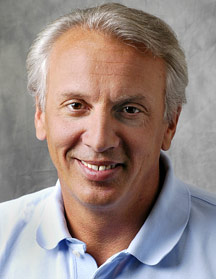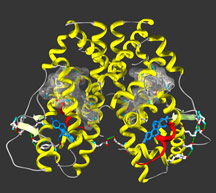

Mixing Basic and Applied Research:
An Interview with John Cleveland
John Cleveland, who arrived at Scripps Florida last fall from St. Jude Children's Research Hospital in Memphis, Tennessee, speaks with Mika Ono of News&Views about his plans for the Department of Cancer Biology, the direction of his own work, and what he finds so exciting about Scripps Florida.
News&Views: Could you tell me about the Department of Cancer Biology?
Cleveland: [Scripps Research Institute President] Richard [Lerner] hired me to bring a focused initiative in cancer research to Scripps. The Department of Cancer Biology provides a collective group dedicated to this arena—and it's an important one in terms of attracting research funds, partnerships with biotech, and interactions with "Big Pharma."
The idea is to conduct outstanding discovery-based basic research in cancer biology and then to apply it using the high-throughput facilities available at Scripps Florida. We use cell-based screening facilities here for target discovery, plug those back into the genetic cancer model systems we have in the department for target validation, then develop assays based on those targets and run them through small molecule therapeutic screens. Once we validate leads, we go back to our model systems. The next step is to try to make real drugs by collaborating with the medicinal chemistry program at Scripps Florida and with cancer centers in the State of Florida to move these drugs into Phase I trials.
At this point, who is in your department?
My group arrived November 1. I have about 10 personnel, including postdocs, staff scientists, and technicians. They will all finally arrive by the beginning of June. My research program is focused on the MYC oncogene, which is activated in 70 percent of human cancers. Part of the work we'll be doing here is taking targets downstream of MYC and using them to develop drugs for some of the big four cancers—prostate, breast, colon, and lung cancer. The lab is currently supported by three long-standing RO1 grants from the National Institutes of Health, and I'll apply for more now I am at Scripps.
Other faculty members in the department include Professor Howard Petrie, who works on T cell development and will be making forays into leukemia. Assistant Professor Nagi Ayad works on ubiquitin-mediated control of the cell cycle and how this goes awry in cancer. Assistant Professor Kendall Nettles runs a hybrid program that uses structural biology and crystallography along with molecular and cellular biology, to identify novel agents that activate and inhibit steroid receptors; his work is widely applicable to cancer biology, but also to many other disciplines, such as inflammatory diseases. Assistant Professor Michael Conkright, who also runs the cell-based screen facility for Scripps Florida institute, works on the cyclic AMP signaling cascade and transcriptional networks.
I've also hired two more investigators. One is Associate Professor Tina Izard, a crystallographer and cell biologist who works on cytoskeletal proteins and how they regulate cell migration and invasion—relevant topics for cancer because metastases are really what kill the cancer patient. I've also hired Assistant Professor Philippe Bois, who works on recombination hotspots and meiosis and cancer. So currently there are five principal investigators in the department, soon to be seven, and I'm recruiting three more.
What are you looking for as you are recruiting new investigators?
I'm looking for programs that are run by the very best "athletes"—strong investigators with strong track records. I'm looking for investigators who are creative and interactive, to foster collaborations with other members of department and the institute, both in terms of their research programs and their use of the high throughput facilities that are available at Scripps Florida.
One of the major initiatives I'll be pushing will be to develop real collaborations and interactions with faculty on the La Jolla campus that have cancer research interests, and to formalize those, perhaps bringing some of the faculty in La Jolla into the Department of Cancer Biology as joint appointments.
It sounds like you've made a lot of progress since you've arrived.
Yes, things have gone very well so far. It's an exciting time. We're recruiting dynamite scientists, and we're recruiting other leaders at the institute in the process. It's a challenging job, but a great one. I'm not only building the department, but am also helping to build the institute and serve on the Scripps Florida Steering Committee for that purpose.
What's exciting about Scripps Florida to you?
Just about everything. It's rare to be offered an opportunity to become part of a new institute and to help build it. I think that only comes around once in one's career. It's also unusual to be given a basically blank slate to build a department, to paint that piece of art.
The research environment at Scripps Florida is unusual and compelling, because it's a true mix of basic academic investigators and researchers from industry, even at the leadership level. For example, you have Bill Roush, who runs the chemistry program here and who was a department chair at the University of Michigan, a true academic. Then you have someone like Pat Griffin, chair of the Department of Molecular Therapeutics, who was at Merck for a number of years and was in Pharma for most of his career. At other levels of the faculty, there are people coming from Pharma who really know how use some of the core facilities here and who are some of the most talented investigators I've ever seen in terms of support staff. The proteomics core here is incredibly strong. Cell-based screening is unique. Small molecule therapeutic screening is probably one of the best of its kind in the world. The talent is quite remarkable.
That's what really sold me on Scripps—the science. It is five years ahead of everybody else. The people here are developing and exploiting the technologies that move science forward. Chemistry here feeds into so many other disciplines in the institute. In fact, I persuaded nine out of the 12 people in my team in Memphis to move with me. The research you can do at Scripps Florida was a huge selling point. The other was the Florida coast. Every day is a perfect day here, and it's 10 degrees hotter in Memphis in the summer.
Tell me a little more about MYC and your work on it.
MYC is a transcription factor that regulates expression of a great number of genes. Michael Bishop and Harold Varmus won the Nobel Prize in 1989 for their discovery of MYC, amongst other proto-oncogenes. MYC gets activated by gene amplification and by chromosomal translocations, but more often, in almost all rapidly dividing tumors, it is overexpressed. The first thing MYC does is to accelerate the rate of cell growth so that mutated cells have an obvious advantage over their normal counterparts.
We showed that MYC is an essential regulator of tumor angiogenesis, the process by which tumor cells recruit blood vessels that then supply the blood and nutrients the tumors need to survive. MYC also regulates other pathways important for cell fate. It blocks differentiation, and our new studies indicate that this is very important for tumorigenesis as well. When differentiation is blocked, the pool of at-risk rapidly dividing cells is increased, creating an environment promoting secondary mutations.
One of the major discoveries of the laboratory was that oncogenes like MYC actually promote apoptosis or cell death when they are overexpressed in normal cells. This point of view was very radical at the time the work was being done, in the late 80s and early 90s, but now it has been widely accepted. We also discovered how MYC induces apoptosis and showed that this pathway is overcome during tumorigenesis, that is, tumor cells undergo mutations that bypass this program. Obviously, if we could reactivate this program, we would have a therapeutic. This is one of the areas we're spending a lot of time on now.
Have you found the perspective of the Scripps Florida scientists with a Pharma background helpful in charting the course of your research here?
Yes, they really bring a lot of added value to our research program. As a scientist, you can have a general idea about making a drug and wanting to do a particular kind of a screen, but if you have never done that for a living, you really don't know what you're talking about. When we interact with the investigators who understand this aspect of the research, it can end up saving years of time, for example, we can go in knowing how rigorous we need to be up front when setting up screens. Here at Scripps Florida, there is a pipeline. Here, you can actually get it done. It's a unique environment. There is really nothing else I've ever seen quite like it.
Do you have something in the works on the drug development side of things?
Yes, we came with targets in hand. Right now, we're developing screens for about four different targets. We'll see where that leads.
Send comments to: mikaono[at]scripps.edu

John Cleveland, chair of the Department of Cancer Biology, calls the research environment at Scripps Florida "unusual and compelling."

One of the investigators in the Department of Cancer Biology is Assistant Professor Kendall Nettles, whose lab has examined activation of the estrogen receptor-a (ER-α). Click for details.
